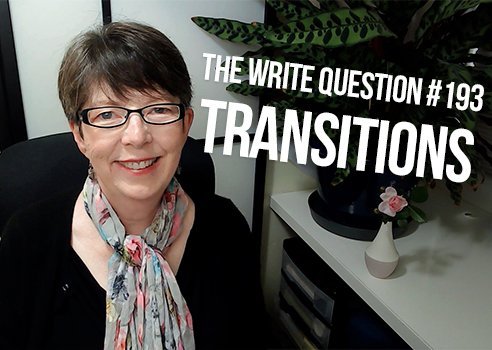Viewing time: 5 mins
The Write Question is a weekly video podcast all about writing. Today’s question? How can you improve your use of transitions? If you have a question you’d like me to answer you can email me, tweet me @pubcoach, or leave a message for me at the Skype account, The Write Question.
Transcript:
How can you improve your use of transitions? That’s the topic I’m addressing today in The Write Question. I’m Daphne Gray-Grant, the Publication Coach, still in pandemic mode.
I have a question from Kate Rakow, a writer based in Confluence, Pennsylvania. Here’s what she’s asked by email…
“Help please! I have a mental block with transitions. I’ve read articles and blogs on the subject, but I still don’t really understand. I’m using the software ProWritingAid for help, and it tells me that transitions are my weakest area. I consistently score at a rate of only 4 to 6 % for transitions when the software suggests I need to be at a rate of greater than 25%. But when I read my work, the writing seems to flow so there is definitely some problem in my perception. What do you suggest I do?”
Thanks for your question, Kate. First, let me congratulate you on using ProWritingAid to improve your writing. It’s the best software I’ve ever found for self-editing. (See link, below.) By the way, I have no affiliate relationship with the company, so I can state my opinion without bias.
Second, for viewers who might be unfamiliar with the concept of transitions, let me provide a quick summary.
Transitions are words and techniques that make your text easier to read. Basically, transitions not only allow readers to see the relationship between ideas, they also prevent troublesome mental leaps between sentences and paragraphs.
And here’s another great thing about transitions. When they work, they’ll be nearly invisible to your readers.
Part of the reason you may not see this issue yourself, Kate, is because you are too close to your own material. After all, you’ve done all the planning, the researching, the thinking, the writing. You KNOW this stuff. So, the transitions aren’t necessary for you. But they will be necessary for your readers.
OK, let’s talk brass tacks. Here are five techniques for using transitions:
1 – Leading or intriguing statements. Here’s an example from a New York Times piece by Jennifer Jett (see link in the show notes): “When spooky things appear in the sky, witnesses have often been reluctant to report them for fear of mockery by others, especially in the halls of government. These days, fewer people are laughing.” Do you see how Jennifer juxtaposed the fear of reporting UFOs with a new lack of fear? That sentence “These days, fewer people are laughing,” acts as a terrific transition.
2 – Questions. The same story also uses a number of questions. Here are a few of them:
· What kinds of things are people reporting?
· What will the report say?
· Who is pushing for more information?
In this story, all the questions are used as subheads. But they needn’t have been. Questions can also go directly in the body of the text.
3 – Introducing characters. Here is how Jennifer Jett introduces one character in her story: “One key backer of U.F.O. research efforts has been Harry Reid, the former Democratic senator from Nevada, who as Senate majority leader secured $22 million in funding to create the 2007 program.” Do you see how stating how much money he was able to secure makes him a much more interesting character?
4 – Repetition. Also, in the same roughly thousand-word story, the word “sightings” is used six times. That repetition, in itself, is a type of transition. Just handle repetition thoughtfully so it doesn’t seem accidental or inept.
5 – Specific words and phrases. In a blog post on my website, there’s a complete list of transitional words you can consider adding to your text. See link below. Here are a few examples: Also, in other words, above all, for example, accordingly, likewise, but, finally, as I have said, in the past.
I sense your frustration, Kate, and I think the best way to approach this issue is to simply work to hit the 25% total recommended by ProWritingAid. Use the five strategies I just outlined, paying particular attention to my list of specific words and phrases.
Finally, let me wrap up with the words of scientist and popular science author Isaac Asimov: “Life is pleasant. Death is peaceful. It’s the transition that’s troublesome.”
Kate, everyone faces certain aspects of writing that seem to defeat them. Over time, and with enough practice, transitions will come to make more sense to you.
*
If you’d like to learn more about how to make writing a happier and more rewarding process, check out my latest book Your Happy First Draft. I don’t sell it in bookstores or via Amazon. The only place to buy it is on my website, link on the screen below and in the show notes.
Links
Why Are We All Talking About U.F.O.s Right Now?


